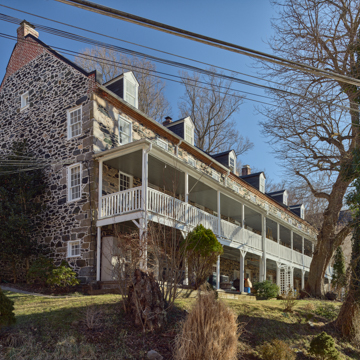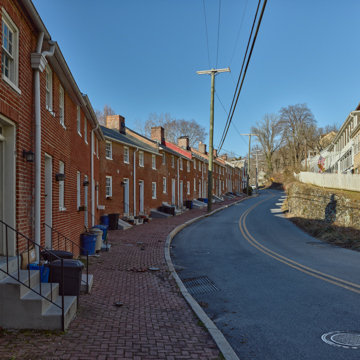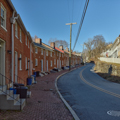The industrial village of Oella was established by the Union Manufacturing Company to house its textile mill workers, later supplemented by housing for the Granite Hill Factory and its successor firm, W. J. Dickey Company. Oella encompasses approximately a hundred housing units dating from the early nineteenth through the early twentieth centuries, along with the last remaining mill, built in 1918. Preserved and rehabilitated, Oella is an intriguing residential community consisting mostly of semidetached and other multi-unit dwellings set along the curving roads and hillsides of this picturesque, steep and densely wooded gorge of the Patapsco River.
Capitalizing on the success of nearby Ellicott’s Mills, Union Manufacturing Company opened a textile mill here in 1808, building the “Stone Row” complex for its workers (871–881 Oella Avenue). Banked into the hillside, the random ashlar granite row features distinctive quoining and tiered galleries. The mill town so captured the imagination of architect Maximillian Godefroy that he created a drawing in 1812 that includes Stone Row.
By 1820, Union was the largest textile mill outside New England. To accommodate the growing workforce, Long Brick Row (c. 1850; 744–780 Oella) was erected. The visually compelling continuous row of two-story, two-bay row houses includes stone stoops, shared chimneys, and firewalls and is articulated to follow the curving contour of the roadway. Nearby three-story brick semidetached houses (1830–1840; 929–947 Oella) feature half-story windows in the third floor.
Granite Hill Factory was established in 1844, and while the mill buildings were destroyed in the devastating flood of 1868, the c. 1844 stone workers’ houses survive (1200–1215 Oella). Overlooking the Patapsco River are three semidetached and two single houses, built of locally quarried granite with quoining and monolithic lintels. The two-and-a-half-story, three-bay units are set on high basements with elevated porches, with the semidetached units sharing a center brick chimney and rear kitchen ell.
The mill town was purchased in 1887 by W. J. Dickey Company, adding two-story, two-bay frame housing units (728–747 Oella) with Italianate details. Following a fire, a new mill (1918; 840 Oella) was built, and operations expanded to include woolen cloth, becoming the largest manufacturer in the South. The brick industrial building with large metal windows and entrance tower is banked along the Patapsco River and the old millrace, rising from four to six stories. Unable to compete with new synthetic fabrics, coupled with a devasting flood, the company was forced to close in 1972. Forming the Oella Company, William Dickey’s grandson, Charles Wagandt, worked with architects, planners, and government officials to rehabilitate the houses while maintaining architectural integrity and ensuring former mill workers were not displaced. The mill was purchased separately and rehabilitated as loft apartments.












